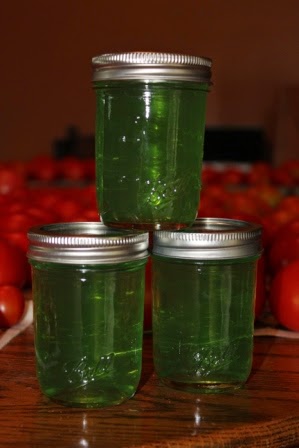If you are like us, this time of year you are inundated with tomatoes. We have had an especially good year, both for the heirlooms and hybrids we grew. Our outstanding favorite among the hybrids is Whopper, developed by Park Seed Co. in South Carolina. It is a determinate tomato, but it branches profusely at the base, forming a "bush" about four feet in diameter. It definitely needs a sturdy wire cage to contain its exuberance. It also produces loads of tasty tomatoes, of uniform size and with small cores, the ideal tomato, in our view, for home canning. Check out the photo. The majority of the fruits are like these, about 8 ounces each. They are also delicious on a sandwich. Here are seven things to do with the seasonal abundance of tomatoes.
1. Freeze Them
Tomatoes freeze easily. Just wash, core and cut them in halves or quarters. Drop into freezer containers and place in the freezer. When thawed, the skins will slip right off and the tomatoes can be used for soup or to make tomato sauce.
2. Can Them
Tomatoes are easy to can because of their acidity, which helps prevent spoilage. You need some special equipment for canning, but the investment is small and the equipment will last many seasons. A large water bath canner with a rack to hold the jars is the main item. If you invest in a jar lifter, canning funnel, and a pair of stainless steel tongs, your canning experience will go much more smoothly.
For instructions on canning tomatoes, visit the web site of the
National Center for Home Food Preservation at the University of Georgia. There you will also find instructions and recipes for many other home canned foods.
3. Juice Them
Tomato juice is canned in exactly the same way as whole tomatoes. A gallon of cored, quartered tomatoes will yield about a half gallon of juice. Tomato juice can be seasoned with small amounts of salt, sugar or spices, like garlic powder or black pepper. It is worth noting that some upscale bars are serving a bloody Mary made with heirloom tomato juice.
4. Sauce Them
Skin, core and chop a couple of quarts of tomatoes. Place them in a saucepan, bring to a simmer and cook, stirring frequently, for 20 minutes. Press through a sieve to remove the seeds. Return the tomato sauce to the heat, add you favorite herbs, a big pinch of salt and some chopped onions, and cook slowly, stirring frequently, until the sauce is thickened. Toss with pasta or use on pizza. Alternatively, cool the sauce to room temperature, transfer to a suitable container, and freeze.
5. Make Stewed Tomatoes
Stewed tomatoes were a popular side dish in the Nineteenth and early Twentieth Centuries, when long cooking was thought to render vegetables more healthful. Peel and core tomatoes and cut them into chunks. Place in a saucepan, bring to a simmer, and cook 15 minutes. Season to taste with salt, pepper and a little sugar. Cool to room temperature and store, covered, in the refrigerator for a week.
6. Make Tomato Pudding
If you happen to have any leftover stewed tomatoes, you can make them into tomato pudding. Oil a baking dish, and line the bottom with stale bread. You can use cornbread, biscuits, yeast bread, or sourdough. Each will give the dish its own character. Break the bread into chunks about the size of a grape. You want a layer about an inch deep on the bottom of the dish. Top the bread with stewed tomatoes, adding a little more salt, sugar and pepper. If you have enough tomatoes, repeat with a second layer of bread, again topping with stewed tomatoes. Sprinkle the top with grated cheese and allow the dish to sit at room temperature for a half hour, to allow the bread to soak up some of the tomato juice. Place in a preheated 350 degree oven for 30 minutes, or until the top is light brown and the edges are bubbly. Serve warm or at room temperature. This basic recipe can be varied endlessly with different seasonings and additions. That is why is was so popular with farm wives, like my grandmother, a century ago.
To Remove Skins
To skin tomatoes, bring a large pot of water to a boil. Select and wash the tomatoes. Using a serrated knife, cut an "X" into the blossom end, cutting just through the skin. Drop a few tomatoes into the boiling water. After 20-30 seconds, remove them with a slotted spoon and transfer to a big bowl of cold water. You will see the skins split immediately, if they have not already. The skin will now easily slip off. Core the tomatoes, transfer them to a bowl, and repeat the process until you have peeled all you need.





















.JPG)

